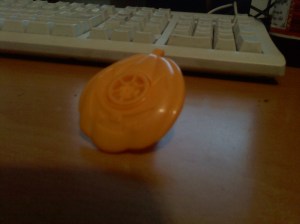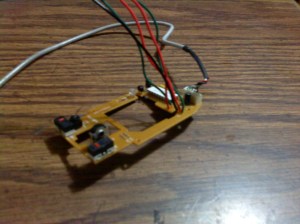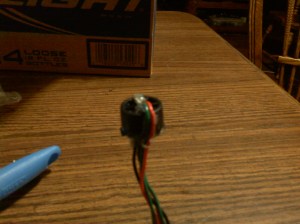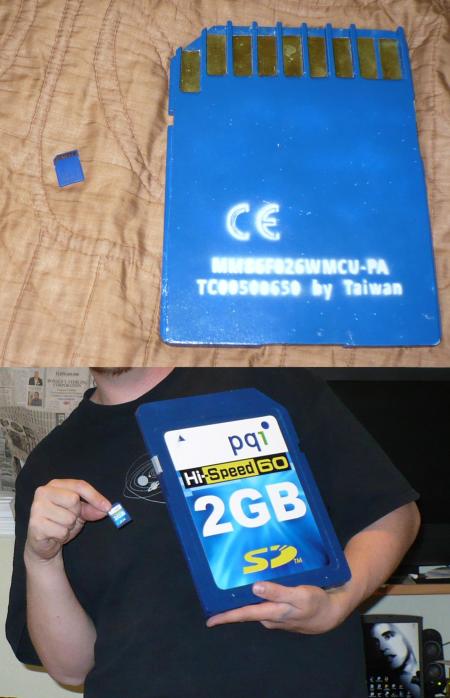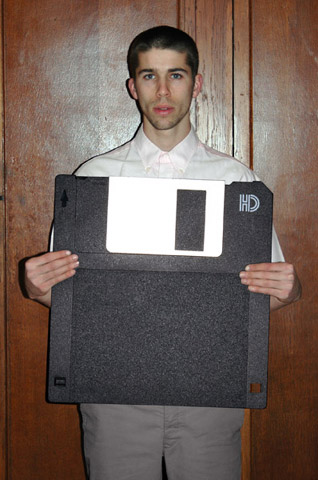Ever since I saw a Staples’ “Easy Button” hacked to play back pre-recorded messages, I have wanted to do something in a similar vein. So, two months ago, while at Staples, I splurged $5 and bought an Easy Button. God, what an annoying little device. Skip ahead to the present when I finally got off my ass and busted the damn thing open.
So what should I do with such an obviously large button? Well, I know I’ve been smashing the ESC key on my keyboard at work a lot recently, so why not make it a single button keyboard?

Parts:
- Staples’ Easy Button
- PS2 Keyboard (cheapest one possible)
- Wire
Tools:
- Screw Drivers
- Dremel Tool
- Soldering Iron/Solder/Etc
- Multi-Meter
- Hot-Melt Glue
- Jumpers (alligator clips connected by a short wire, for testing)
Preparation:
The first keyboard I could find in my office’s junk storage room happend to be light and simple. I cracked it open and found the entirety of the electronics to reside on a PCB less than 2.5″ x 1.25″. The easy part was tracing the leads for the ESC key to PCB pinouts. I literally used a sharpie to trace the lines to their source.


I then gutted the Easy Button. Small screws made it a quick disassembly with no breaking of plastic or need of force. The speaker popped out easy enough and even though I cut the leads to the batteries, the sound module and speaker are still intact (possible for a little circuit bending :). Originally, I was going to try to place the keyboard PCB where the Button’s PCB was, but it was just too long. I had to relocate it to the very bottom of the button, requiring me to cut away parts of the battery and speaker holder with my handy-dandy Dremel Tool (Best. Purchase. Ever.).

Now that I had a good idea as to the layout, I needed proof of design. So, using the jumpers and googled pinouts, I wired up the parts and plugged it in to a computer. HUZZAH! I successfully connect two wires to close a dialogue box in windows.

A little bit of soldering later, I place the PCB in the button, and make sure all the parts fit together snugly. Now to make it permanent, I used a hi-heat glue gun to keep the PCB in place. The next bit of plastic on top of that was next to get glue. I soldered a bit of metal on the end of one of the ESC key leads and glued it underneath the metal spring from which the button gets its action. The other lead wouldn’t adhere to metal spring, so I had to bust one of my Dremel bits to put a hole big enough for a wire to go though in it.

That was it! One last demo before closing the case up for good.

… well this is bad… some extra buttons are apparently being activated, as when plugged it, IE flashes incessantly into full screen. And because I used hot melt glue directly on the PCB, there’s no way to re-solder the bad leads.

So, with a failed project on my hands, I closed up the case, cleaned up, and put it on my ever present Shelf-of-Failures.
Perhaps my Telephone Handset hands-free conversion will have better success…
After thinking it over…
I’ve come to realize what went wrong. When I soldered the leads to the contacts on the pcb, I had to scrape away some black coating, presumably conductive adhesive. This left me with a silver bit of metal to latch on to. Looking back, the wire I used was way too heavy a guage to connect the contacts to the switch leads. Regardless, one of the exposed contacts came loose as I was putting it together. I would assume that its shorting with an adjacent contact… or two. 😦 I Hope to use my dremel to take a rectangular bit off the plastic bottom so i can melt some of the glue and fix the short…
The next day…
I took my dremel to the back of the button, removing a strip of plastic that runs along the row of contatcs. Now I was lucky that very little hot melt glue got on the contacts, but somehow, the lead that had pealed off was broken off where it becomes sandwiched in the pcb. I grabbed my dremel tool again, this time with a wide grinding bit of high grit. This allowed me to just brush up against the pcb, to expose a small patch of copper to solder. After a bit of finagling, I got the wire to hold.

Again I tested it on a computer and voila, it works! Quickly, I used some spare bits of plastic from the battery holder to cover the plastic that was removed.

Hot Melt glue will hopefully keep the contact inplace and working for a long time. If it fails after this, I will just shelve this project.

Thats it! Success! I would take this to work tomorrow, but my workstation is on the fritz so I am working off my laptop, which lacks a PS2 keyboard port. Oh well.

